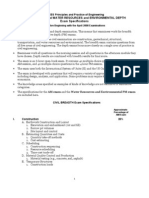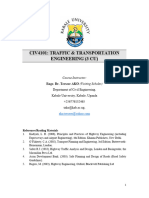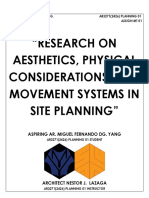Specifications
Specifications
Uploaded by
Seungwoo ParkCopyright:
Available Formats
Specifications
Specifications
Uploaded by
Seungwoo ParkCopyright
Available Formats
Share this document
Did you find this document useful?
Is this content inappropriate?
Copyright:
Available Formats
Specifications
Specifications
Uploaded by
Seungwoo ParkCopyright:
Available Formats
NCEES Principles and Practice of Engineering Examination
CIVIL–TRANSPORTATION CBT Exam Specifications
Effective Beginning January 1, 2022
• The exam topics have not changed since April 2015 when they were originally published.
• The exam is computer-based. It is closed book with electronic references. The NCEES PE Civil
Reference Handbook is included in the exam along with the design standards shown on the last two
pages.
• Examinees have 9 hours to complete the exam, which contains 80 questions. The 9-hour time
includes a tutorial and an optional scheduled break. Examinees work all questions.
• The exam uses both the International System of units (SI) and the U.S. Customary System (USCS).
• The exam is developed with questions that will require a variety of approaches and methodologies,
including design, analysis, and application.
• The examples specified in knowledge areas are not exclusive or exhaustive.
Number of Questions
1. Project Planning 4–6
A. Quantity take-off methods
B. Cost estimating
C. Project schedules
D. Activity identification and sequencing
2. Means and Methods 3–5
A. Construction loads
B. Construction methods
C. Temporary structures and facilities
3. Soil Mechanics 5–8
A. Lateral earth pressure
B. Soil consolidation
C. Effective and total stresses
D. Bearing capacity
E. Foundation settlement
F. Slope stability
4. Structural Mechanics 5–8
A. Dead and live loads
B. Trusses
C. Bending (e.g., moments and stresses)
D. Shear (e.g., forces and stresses)
E. Axial (e.g., forces and stresses)
F. Combined stresses
G. Deflection
H. Beams
I. Columns
J. Slabs
K. Footings
L. Retaining walls
5. Hydraulics and Hydrology 6–9
A. Open-channel flow
B. Stormwater collection and drainage (e.g., culvert, stormwater inlets, gutter flow,
street flow, storm sewer pipes)
C. Storm characteristics (e.g., storm frequency, rainfall measurement and distribution)
D. Runoff analysis (e.g., Rational and SCS/NRCS methods, hydrographic application,
runoff time of concentration)
E. Detention/retention ponds
F. Pressure conduit (e.g., single pipe, force mains, Hazen-Williams, Darcy-Weisbach,
major and minor losses)
G. Energy and/or continuity equation (e.g., Bernoulli)
6. Geometrics 3–5
A. Basic circular curve elements (e.g., middle ordinate, length, chord, radius)
B. Basic vertical curve elements
C. Traffic volume (e.g., vehicle mix, flow, and speed)
7. Materials 5–8
A. Soil classification and boring log interpretation
B. Soil properties (e.g., strength, permeability, compressibility, phase relationships)
C. Concrete (e.g., nonreinforced, reinforced)
D. Structural steel
E. Material test methods and specification conformance
F. Compaction
8. Site Development 4–6
A. Excavation and embankment (e.g., cut and fill)
B. Construction site layout and control
C. Temporary and permanent soil erosion and sediment control (e.g., construction
erosion control and permits, sediment transport, channel/outlet protection)
D. Impact of construction on adjacent facilities
E. Safety (e.g., construction, roadside, work zone)
9. Traffic Engineering (Capacity Analysis and Transportation Planning) 10–15
A. Uninterrupted flow (e.g., level of service, capacity)
B. Street segment interrupted flow (e.g., level of service, running time, travel speed)
C. Intersection capacity (e.g., at grade, signalized, roundabout, interchange)
D. Traffic analysis (e.g., volume studies, peak hour factor, speed studies,
modal split)
E. Trip generation and traffic impact studies
F. Accident analysis (e.g., conflict analysis, accident rates, collision diagrams)
G. Nonmotorized facilities (e.g., pedestrian, bicycle)
H. Traffic forecast
I. Highway safety analysis (e.g., crash modification factors, Highway
Safety Manual)
10. Horizontal Design 3–5
A. Basic curve elements (e.g., middle ordinate, length, chord, radius)
B. Sight distance considerations
C. Superelevation (e.g., rate, transitions, method, components)
D. Special horizontal curves (e.g., compound/reverse curves, curve widening,
coordination with vertical geometry)
11. Vertical Design 3–5
A. Vertical curve geometry
B. Stopping and passing sight distance (e.g., crest curve, sag curve)
C. Vertical clearance
12. Intersection Geometry 3–5
A. Intersection sight distance
B. Interchanges (e.g., freeway merge, entrance and exit design, horizontal design,
vertical design)
C. At-grade intersection layout, including roundabouts
13. Roadside and Cross-Section Design 3–5
A. Forgiving roadside concepts (e.g., clear zone, recoverable slopes, roadside
obstacles)
B. Barrier design (e.g., barrier types, end treatments, crash cushions)
C. Cross-section elements (e.g., lane widths, shoulders, bike lane, sidewalks)
D. Americans with Disabilities Act (ADA) design considerations
14. Signal Design 3–5
A. Signal timing (e.g., clearance intervals, phasing, pedestrian crossing timing,
railroad preemption)
B. Signal warrants
15. Traffic Control Design 3–5
A. Signs and pavement markings
B. Temporary traffic control
16. Geotechnical and Pavement 4–6
A. Sampling and testing (e.g., subgrade resilient modulus, CBR, R-Values, field tests)
B. Soil stabilization techniques, settlement and compaction, excavation, embankment,
and mass balance
C. Design traffic analysis and pavement design procedures (e.g., flexible and
rigid pavement)
D. Pavement evaluation and maintenance measures (e.g., skid, roughness,
rehabilitation treatments)
17. Drainage 2–4
A. Hydrology (e.g., Rational method, hydrographs, SCS/NRCS method), including
runoff detention/retention/water quality mitigation measures
B. Hydraulics, including culvert and stormwater collection system design (e.g., inlet
capacities, pipe flow, hydraulic energy dissipation), and open-channel flow
18. Alternatives Analysis 1–3
A. Economic analysis (e.g., present worth, lifecycle costs)
NCEES Principles and Practice of Engineering Examination
TRANSPORTATION Design Standards
Effective Beginning with the January 2022 Examination
In addition to the NCEES PE Civil Reference Handbook, the following codes and standards will be supplied in the
exam as searchable, electronic pdf files with links for easy navigation. This NCEES YouTube video shows how
standards will be presented on the exam. Standards will be provided as individual chapters on the exam, and only one
chapter at a time can be opened and searched. This ensures the exam software runs large files effectively.
The handbook and design standards will be available the entire exam, though design standards are not needed for the
breadth portion.
Solutions to exam questions that reference a standard of practice are scored based on this list and the revision year
shown. Solutions based on other standards will not receive credit.
NCEES does not sell design standards or printed copies of the NCEES handbook. The NCEES handbook is accessible
from your MyNCEES account.
ABBREVIATION DESIGN STANDARD TITLE
AASHTO A Policy on Geometric Design of Highways and Streets, 7th edition, 2018
GDHS-7 (including October 2019 errata), American Association of State Highway &
Transportation Officials, Washington, D.C., www.transportation.org.
AASHTO Guide for Design of Pavement Structures, 4th edition, 1993 with 1998
GDPS-4-M supplement, American Association of State Highway & Transportation Officials,
Washington, D.C., www.transportation.org.
AASHTO Guide for the Planning, Design, and Operation of Pedestrian Facilities,
GPF-1 1st edition, 2004, American Association of State Highway & Transportation
Officials, Washington, D.C., www.transportation.org.
AASHTO Highway Safety Manual, 1st edition, 2010, with 2014 Supplement
HSM-1 (including September 2010, February 2012, and March 2016 errata), American
Association of State Highway & Transportation Officials, Washington, D.C.,
www.transportation.org.
AASHTO Mechanistic-Empirical Pavement Design Guide: A Manual of Practice,
MEPDG-2 2nd edition, August 2015, American Association of State Highway &
Transportation Officials, Washington, D.C., www.transportation.org.
AASHTO Roadside Design Guide, 4th edition, 2011 (including February 2012 and
RSDG-4 July 2015 errata), American Association of State Highway & Transportation
Officials, Washington, D.C., www.transportation.org.
FHWA HIF-12-026 Hydraulic Design of Highway Culverts, Hydraulic Design Series
Number 5, 3rd edition, April 2012, U.S. Department of Transportation, Federal
Highway Administration, Washington, D.C., www.fhwa.dot.gov.
HCM Highway Capacity Manual (Volumes 1–4), 6th edition, 2016, Transportation
Research Board, National Research Council, Washington, D.C., www.mytrb.org.
MUTCD Manual on Uniform Traffic Control Devices for Streets and Highways, 2009,
including Revisions 1 and 2 dated May 2012, U.S. Department of Transportation,
Federal Highway Administration, Washington, D.C., www.mutcd.fhwa.dot.gov.
You might also like
- DMV Cheat SheetDocument3 pagesDMV Cheat SheetYue Sun56% (9)
- PE Civil - Structural Practice ExamDocument98 pagesPE Civil - Structural Practice Examdavid caon100% (2)
- Highway Design Manual (V1)Document207 pagesHighway Design Manual (V1)N V Sumanth VallabhaneniNo ratings yet
- Basic Guidelines On Pedestrian FacilitiesDocument14 pagesBasic Guidelines On Pedestrian Facilitiesshafawiishak75% (4)
- ATJ 10 - 86 A Guide To The Design of Cycle TrackDocument10 pagesATJ 10 - 86 A Guide To The Design of Cycle Trackmroys100% (1)
- ACPA - Guide For Design and Construction of Concrete IntersectionsDocument28 pagesACPA - Guide For Design and Construction of Concrete IntersectionsSuhas Joshi0% (1)
- DPWH Road Signs and Pavement Markings May 2011 CompleteDocument360 pagesDPWH Road Signs and Pavement Markings May 2011 CompleteJan McZeal Bandao83% (53)
- Idp3-Road DesignDocument52 pagesIdp3-Road Designnuralazim kamarudin100% (7)
- Road Intersection - : Types of Road Intersections Highway CrossingsDocument40 pagesRoad Intersection - : Types of Road Intersections Highway CrossingsAlbyNo ratings yet
- Ra 4136Document108 pagesRa 4136Veritas Vitae Magistra83% (6)
- Civ Con April 2022 r2Document5 pagesCiv Con April 2022 r2boNo ratings yet
- Con AprilDocument4 pagesCon AprilCha AkpNo ratings yet
- Civ WRE April 2022 r2Document5 pagesCiv WRE April 2022 r2Alexander HunterNo ratings yet
- Civ STR April 2022 - r3Document5 pagesCiv STR April 2022 - r3John Emerald GoloNo ratings yet
- Civ STR April 2022 - r2Document5 pagesCiv STR April 2022 - r2Heeraian NambiaNo ratings yet
- 2014 NCEES 8hr Exam StandardsDocument6 pages2014 NCEES 8hr Exam StandardsTioAntonioNo ratings yet
- Civ Con April 2016 With Design StandardsDocument4 pagesCiv Con April 2016 With Design StandardsAbuali Ahmad AbualiNo ratings yet
- Civ-Geo-2022 PE EXAM GUIDEDocument6 pagesCiv-Geo-2022 PE EXAM GUIDEChiblings0% (1)
- Fundamentals of Engineering (FE) CIVIL CBT Exam SpecificationsDocument4 pagesFundamentals of Engineering (FE) CIVIL CBT Exam SpecificationsFawwaz AidNo ratings yet
- Exam Specifications PE Civil PE Civ StructuralDocument6 pagesExam Specifications PE Civil PE Civ Structuralsilvereyes18100% (1)
- FE-Civil-CBT-specs-1 2020Document3 pagesFE-Civil-CBT-specs-1 2020Joselin RothschildNo ratings yet
- PE Exam Specs Civil 2022Document26 pagesPE Exam Specs Civil 2022Sando Anugerah Indonesia PTNo ratings yet
- PE Civil Construction Apr 2008 PDFDocument6 pagesPE Civil Construction Apr 2008 PDFsokos1940No ratings yet
- PE Civil Engineering - Structural Exam SpecsDocument6 pagesPE Civil Engineering - Structural Exam SpecsCristina Garzozi100% (1)
- CIVIL BREADTH Exam Specifications: I. Project PlanningDocument4 pagesCIVIL BREADTH Exam Specifications: I. Project Planningnp091083No ratings yet
- Basic Highway Design ChecklistDocument13 pagesBasic Highway Design ChecklistSyed Ali Raza ShahNo ratings yet
- Geometric Design Strategic Research ProgramDocument28 pagesGeometric Design Strategic Research ProgramAkhmadRifaniNo ratings yet
- FR Cfire0520 PDFDocument89 pagesFR Cfire0520 PDFingof1000No ratings yet
- Updated 2080 Transportation-Engg-IDocument2 pagesUpdated 2080 Transportation-Engg-IKapil ShresthaNo ratings yet
- Fiilncees: Fundamentals of Engineering (Fe) Civil CBT Exam Specifications Effective Beginning With The July ExaminationsDocument3 pagesFiilncees: Fundamentals of Engineering (Fe) Civil CBT Exam Specifications Effective Beginning With The July ExaminationsMohamed HassanNo ratings yet
- Week 1 - IntroductionDocument41 pagesWeek 1 - IntroductionjosephNo ratings yet
- Petroleum: NCEES Principles and Practice of Engineering ExaminationDocument4 pagesPetroleum: NCEES Principles and Practice of Engineering Examinationreza khNo ratings yet
- Basic Highway Design Checklist PDFDocument13 pagesBasic Highway Design Checklist PDFirfan_960No ratings yet
- 3-Lecture 0 (CE-443)Document18 pages3-Lecture 0 (CE-443)Arsalan AhmadNo ratings yet
- PE Pet Oct 2023 CBT - FinalDocument3 pagesPE Pet Oct 2023 CBT - FinalNoel JenningsNo ratings yet
- Code of EthicsDocument14 pagesCode of EthicsMatthew WeeNo ratings yet
- Subject Area Civil - Construction Depth Study Schedule: Geotechnical Engineering (20%)Document10 pagesSubject Area Civil - Construction Depth Study Schedule: Geotechnical Engineering (20%)gullipalliNo ratings yet
- Fe Latest Civil Practice 2023 - RevDocument111 pagesFe Latest Civil Practice 2023 - RevWaiNo ratings yet
- 502 Highway EngineeringDocument5 pages502 Highway EngineeringKARAN TRIVEDINo ratings yet
- Exam Specifications - PE Civil - PE Civil Geo Oct 2011Document5 pagesExam Specifications - PE Civil - PE Civil Geo Oct 2011Dime CeselkoskiNo ratings yet
- Seminar On Surveys and Investigation (1!31!08)Document66 pagesSeminar On Surveys and Investigation (1!31!08)John Joseph EstebanNo ratings yet
- Course Plan CE-860 PDA - 2019Document2 pagesCourse Plan CE-860 PDA - 2019Jalal HabibNo ratings yet
- Bridge Engineering: Chapter 1: Introduction & Concept DesignDocument44 pagesBridge Engineering: Chapter 1: Introduction & Concept Designengsalam100% (1)
- Pe Civil Wre Apr 2008Document6 pagesPe Civil Wre Apr 2008Gabriel LeonardoNo ratings yet
- FE Civil CBT Specs With RangesDocument4 pagesFE Civil CBT Specs With RangesSanam AfreenNo ratings yet
- Introduction Route SelectionDocument9 pagesIntroduction Route SelectionbelshaNo ratings yet
- Highway Engineering I Chapter One: Instructor: Mesfin D. AddressesDocument28 pagesHighway Engineering I Chapter One: Instructor: Mesfin D. AddressesYUlian TarikuNo ratings yet
- Bridge Design PresentationDocument73 pagesBridge Design PresentationAkshay joshi100% (1)
- EE101 Transportation Engineering-Lecture 1Document4 pagesEE101 Transportation Engineering-Lecture 1Israel PopeNo ratings yet
- Roadway Cross-Sections - USDocument54 pagesRoadway Cross-Sections - USSayal SattarNo ratings yet
- PE Civil: Geotechnical Exam GuideDocument5 pagesPE Civil: Geotechnical Exam GuideNader Mehdawi100% (1)
- Design Criteria For Highways and RailwaysDocument7 pagesDesign Criteria For Highways and RailwaysDale MalazzabNo ratings yet
- C04-033 - Intersection Geometric Design - USDocument56 pagesC04-033 - Intersection Geometric Design - USDabon Jade Denver MacalitongNo ratings yet
- CE742 Pavement Systems Engineering 201040410Document4 pagesCE742 Pavement Systems Engineering 201040410Arnav ChoudhryNo ratings yet
- Referensi Jalan RayaDocument13 pagesReferensi Jalan RayaSinta SartikaNo ratings yet
- Road Blog 1Document4 pagesRoad Blog 1shoaib60625966No ratings yet
- Sure! Here are-WPS OfficeDocument7 pagesSure! Here are-WPS OfficekevautistaNo ratings yet
- Traffic & Transport (2024) .Document30 pagesTraffic & Transport (2024) .Fred MukisaNo ratings yet
- CeDocument5 pagesCeG LeeNo ratings yet
- ChtsyllDocument48 pagesChtsyllMohammad Ibna AnwarNo ratings yet
- Transportation Engineering CHDocument1 pageTransportation Engineering CHMalik ZainNo ratings yet
- 5.5 Transportation Engineering-I (PDF) by Akshay ThakurDocument91 pages5.5 Transportation Engineering-I (PDF) by Akshay ThakurAashu chaudharyNo ratings yet
- IRISE Brainstorm Summary FINALDocument4 pagesIRISE Brainstorm Summary FINALAnurag KumarNo ratings yet
- Introduction & Route Selection PDFDocument9 pagesIntroduction & Route Selection PDFJiregna ChalchisaNo ratings yet
- 4 Pavement Structure Thickness DesignDocument89 pages4 Pavement Structure Thickness DesignLynas Beh Tahan100% (2)
- Rational Structural Design of Highway/Airport Pavements: New Evapave, the Strongest & Toughest Paving MaterialFrom EverandRational Structural Design of Highway/Airport Pavements: New Evapave, the Strongest & Toughest Paving MaterialNo ratings yet
- Guide for Planning, Construction and Maintenance of Forest RoadsFrom EverandGuide for Planning, Construction and Maintenance of Forest RoadsNo ratings yet
- Sustainable Winter Road OperationsFrom EverandSustainable Winter Road OperationsXianming ShiNo ratings yet
- Depth ExamDocument19 pagesDepth ExamSeungwoo ParkNo ratings yet
- Transportation Depth ReferencesDocument10 pagesTransportation Depth ReferencesSeungwoo ParkNo ratings yet
- GE OregonDocument2 pagesGE OregonSeungwoo ParkNo ratings yet
- GS-0810 RequirementsDocument5 pagesGS-0810 RequirementsSeungwoo ParkNo ratings yet
- Gilman Springs Road Safety Improvement Project Slide PresentationDocument10 pagesGilman Springs Road Safety Improvement Project Slide PresentationThe Press-Enterprise / pressenterprise.comNo ratings yet
- Test 11Document9 pagesTest 11basusumpitaNo ratings yet
- Cdi Traffic Management and Accident InvestigationDocument34 pagesCdi Traffic Management and Accident InvestigationHaimelien De Limos50% (2)
- Traffic Management... (CDI 231) EDocument44 pagesTraffic Management... (CDI 231) EMarianne GabrielNo ratings yet
- Study of Automatic Traffic Signal SystemDocument8 pagesStudy of Automatic Traffic Signal Systemkunwar.gecNo ratings yet
- Cdi Module MidtermDocument20 pagesCdi Module MidtermMark Jayson Pampag Muyco100% (2)
- DirectionsDocument8 pagesDirectionsLílian LopesNo ratings yet
- Technical Schedule MP pROJECTDocument48 pagesTechnical Schedule MP pROJECTRashmi Ranjan SamalNo ratings yet
- ResearchDocument3 pagesResearchloli kawaiiNo ratings yet
- Ontario Driver - S Handbook - Part 1Document19 pagesOntario Driver - S Handbook - Part 1David SdaoNo ratings yet
- Traffic ControlDocument8 pagesTraffic ControlFadli AdhityaNo ratings yet
- Research On Aesthetics, Physical Considerations, and Movement Systems in Site Planning - YangDocument18 pagesResearch On Aesthetics, Physical Considerations, and Movement Systems in Site Planning - YangMiggy YangNo ratings yet
- Minor Project On Design of Traffic SignalsDocument22 pagesMinor Project On Design of Traffic SignalsBrijesh Kumar100% (5)
- Nfpa - 1451 - 2007 InglesDocument36 pagesNfpa - 1451 - 2007 InglesJean Vaughan eSafetyDesignNo ratings yet
- Oregon Drivers Manual - Oregon Drivers HandbookDocument128 pagesOregon Drivers Manual - Oregon Drivers HandbookpermittestNo ratings yet
- Math 9 - TransportationDocument4 pagesMath 9 - TransportationPalabyo NaborNo ratings yet
- ChanlizationDocument86 pagesChanlizationZAIN AHMEDNo ratings yet
- Megapolis Transport Masterplan - FinalDocument202 pagesMegapolis Transport Masterplan - FinalDhammika PereraNo ratings yet
- Forensic Investigation of Road AccidentsDocument13 pagesForensic Investigation of Road AccidentsTejinder SinghNo ratings yet
- O10551-2007 (Providing For The Traffic Code of Cagayan de Oro City) Second and Final ReadingDocument73 pagesO10551-2007 (Providing For The Traffic Code of Cagayan de Oro City) Second and Final ReadingCdeoCityCouncilNo ratings yet
- s9 1Document18 pagess9 1malumasusu4No ratings yet
- AASHTO Policy On Geometric Design of Highways and Streets 2001Document47 pagesAASHTO Policy On Geometric Design of Highways and Streets 2001Gyan GriBaldiNo ratings yet





























































































